
The Vought F4U Corsair is an American fighter aircraft that saw service primarily in World War II and the Korean War. Designed and initially manufactured by Chance Vought, the Corsair was soon in great demand; additional production contracts were given to Goodyear, whose Corsairs were designated FG, and Brewster, designated F3A.
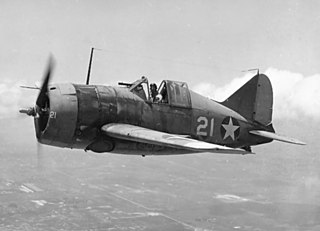
The Brewster F2A Buffalo is an American fighter aircraft which saw service early in World War II. Designed and built by the Brewster Aeronautical Corporation, it was one of the first U.S. monoplanes with an arrestor hook and other modifications for aircraft carriers. The Buffalo won a competition against the Grumman F4F Wildcat in 1939 to become the U.S. Navy's first monoplane fighter aircraft. Although superior to the Grumman F3F biplane it replaced, and the early F4Fs, the Buffalo was largely obsolete when the United States entered the war, being unstable and overweight, especially when compared to the Japanese Mitsubishi A6M Zero.
The Curtiss-Wright Corporation is a manufacturer and services provider headquartered in Davidson, North Carolina, with factories and operations in and outside the United States. Created in 1929 from the consolidation of Curtiss, Wright, and various supplier companies, the company was immediately the country's largest aviation firm and built more than 142,000 aircraft engines for the U.S. military during World War II.
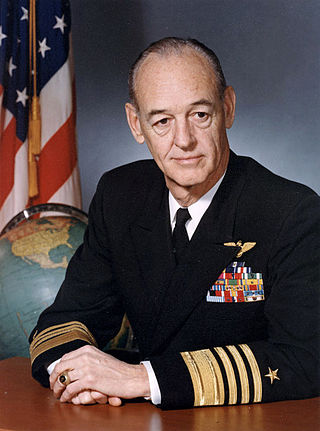
John Smith Thach was a World War II Naval Aviator, air combat tactician, and United States Navy admiral. Thach developed the Thach Weave, a combat flight formation which could counter enemy fighters of superior performance, and later the big blue blanket, an aerial defense against kamikaze attacks.

The Grumman F4F Wildcat is an American carrier-based fighter aircraft that entered service in 1940 with the United States Navy, and the British Royal Navy where it was initially known as the Martlet. First used by the British in the North Atlantic, the Wildcat was the only effective fighter available to the United States Navy and Marine Corps in the Pacific Theater during the early part of the Second World War. The disappointing Brewster Buffalo was withdrawn in favor of the Wildcat and replaced as aircraft became available.

The Grumman F6F Hellcat is an American carrier-based fighter aircraft of World War II. Designed to replace the earlier F4F Wildcat and to counter the Japanese Mitsubishi A6M Zero, it was the United States Navy's dominant fighter in the second half of the Pacific War. In gaining that role, it prevailed over its faster competitor, the Vought F4U Corsair, which initially had problems with visibility and carrier landings.

Vought was the name of several related American aerospace firms. These have included, in the past, Lewis and Vought Corporation, Chance Vought, Vought-Sikorsky, LTV Aerospace, Vought Aircraft Companies, and Vought Aircraft Industries.

Dobbins Air Reserve Base or Dobbins ARB is a United States Air Force reserve air base located in Marietta, Georgia, a suburb about 20 miles (32 km) northwest of Atlanta. Originally known as Dobbins Air Force Base, it was named in honor of Captain Charles M. Dobbins, a World War II C-47 pilot who died near Sicily.
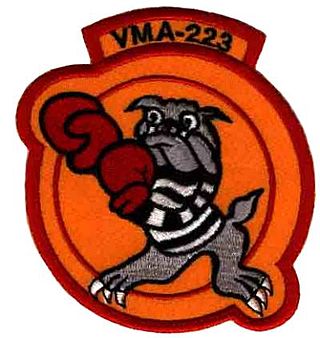
Marine Attack Squadron 223 (VMA-223) is a United States Marine Corps fixed wing attack squadron that consists of McDonnell-Douglas AV-8B Harrier II (V/STOL) jets. The squadron is based at Marine Corps Air Station Cherry Point, North Carolina and falls under the command of Marine Aircraft Group 14 (MAG-14) and the 2nd Marine Aircraft Wing. The squadron uses "Stone" as its radio callsign.

The Brewster SB2A Buccaneer is a single-engined mid-wing monoplane scout bomber aircraft built by the Brewster Aeronautical Corporation for the United States Navy between 1942 and 1944. It was also supplied to the Royal Air Force (RAF), United States Army Air Forces, and United States Marine Corps. The Buccaneer was overweight and lacked maneuverability, and has been described as a "classic failure." While designed as a scout bomber, none saw combat, although a number found use in noncombat roles.
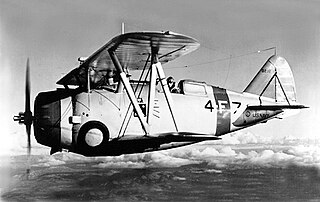
The Grumman F3F is a biplane fighter aircraft produced by the Grumman aircraft for the United States Navy during the mid-1930s. Designed as an improvement on the F2F, it entered service in 1936 as the last biplane to be delivered to any American military air arm. It was retired from front line squadrons at the end of 1941 before it could serve in World War II, and replaced by the Brewster F2A Buffalo. The F3F, which inherited the Leroy Grumman-designed retractable main landing gear configuration first used on the Grumman FF, served as the basis for a biplane design ultimately developed into the much more successful F4F Wildcat that succeeded the subpar Buffalo.

The Naval Aircraft Factory SBN was a United States three-seat mid-wing monoplane scout bomber/torpedo aircraft designed by the Brewster Aeronautical Corporation and built under license by the Naval Aircraft Factory in Philadelphia, Pennsylvania. The landing gear was similar to that on the Brewster F2A Buffalo fighter aircraft. The SBN had non-folding wings with perforated flaps.

The Grumman FF "Fifi" was an American biplane fighter aircraft operated by the United States Navy during the 1930s. It was the first carrier aircraft with retractable landing gear. It was produced under licence in Canada and known as the Goblin in Canadian service and Delfín in Spanish service.
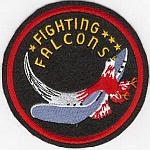
Marine Fighting Squadron 221 (VMF-221) was a reserve fighter squadron of the United States Marine Corps. Originally commissioned during the World War II, it flew the Brewster F2A-3, and after reconstitution in 1943, the F4U Corsair. The squadron, also known as the "Fighting Falcons", is most notable for its actions on 4 June 1942, during the Battle of Midway, which resulted in 23 members of the squadron, many posthumously, being awarded the Navy Cross for their actions in combat. VMF-221 ended World War II with 185 air-to-air victories, the second most of any Marine Fighting Squadron in the war.

The VL Humu (Whirlwind) is a Finnish fighter aircraft, designed by Valtion lentokonetehdas in 1944, and based on the American Brewster F2A Buffalo.

Vice Admiral James Henry Flatley Jr. was a World War II naval aviator and tactician for the United States Navy (USN). He became a fighter ace credited with shooting down six enemy aircraft in aerial combat.
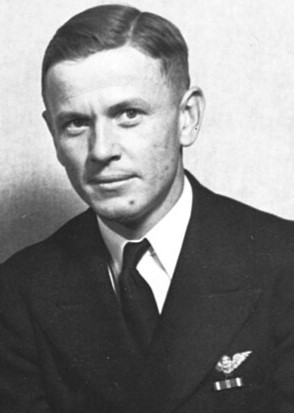
John Thomas Blackburn was an American naval aviator, World War II flying ace, and the first commanding officer of the famed F4U Corsair squadron VF-17 Jolly Rogers.

The Brewster Building is a 400,000-square-foot (37,000 m2) building at 27-01 Queens Plaza North in Long Island City, Queens, New York City. Once an assembly plant for Rolls-Royce automobiles, Brewster automobiles, and Brewster airplanes, in particular the Brewster F2A Buffalo fighter and the SB2A Buccaneer light bomber, it later became the corporate headquarters for JetBlue Airways.
Fighting Squadron 9 or VF-9 was an aviation unit of the U.S. Navy, originally established on 1 March 1942, it was disestablished on 28 September 1945.




















